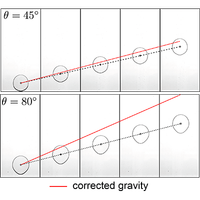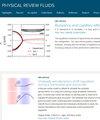Bubble dynamics in an inclined Hele-Shaw cell
IF 2.5
3区 物理与天体物理
Q2 PHYSICS, FLUIDS & PLASMAS
引用次数: 0
Abstract
We report experimental results on the dynamics of large bubbles in a Hele-Shaw cell subject to various inclination angles with respect to gravity. Low Reynolds number cases are studied by injecting bubbles in a stagnant water/UCON mixture in three different Hele-Shaw cell geometry. The leading order rise speed follows the Taylor-Saffman limit which is inversely proportional to the viscosity , but directly proportional to the square of the cell gap and the effective gravity, accounting for cell tilt angle . However, when the cell is increasingly inclined, the bubble buoyancy in the cell gap leads to a substantial decrease in the rise speed, as compared to the Taylor-Saffman speed. Buoyancy pushes the bubble toward the top channel wall, whereby a difference between the lubrication film thickness on top of and underneath the rising bubble occurs. We attribute these observations to the loss of symmetry in the channel gap, due to cell inclination. Nonetheless, the top lubrication film is observed to follow the Bretherton scaling, namely, , where is the liquid surface tension while the bottom film does not exhibit such a scaling. Finally, we illustrate that a model incorporating a friction term to the power balance between buoyancy and viscous dissipation matches well with all experimental data.

倾斜海尔-肖电池中的气泡动力学
我们报告了在与重力呈不同倾角的赫勒-肖池中大气泡的动力学实验结果。通过在三种不同几何形状的 Hele-Shaw 小室中将气泡注入停滞的水/UCON 混合物,研究了低雷诺数情况。前阶上升速度 vb 遵循泰勒-萨夫曼极限,与粘度 η 成反比,但与电池间隙 h 的平方和有效重力成正比,并考虑了电池倾斜角 θ。然而,当电池越来越倾斜时,与泰勒-萨夫曼速度相比,电池间隙中的气泡浮力导致上升速度大幅下降。浮力将气泡推向通道顶壁,因此上升气泡顶部和底部的润滑膜厚度出现差异。我们将这些观察结果归因于细胞倾斜导致通道间隙失去对称性。尽管如此,我们观察到顶部润滑膜遵循布雷特顿缩放比例,即 (ηvb/σ)2/3,其中 σ 是液体表面张力,而底部润滑膜则没有这种缩放比例。最后,我们说明,在浮力和粘性耗散之间的功率平衡中加入摩擦项的模型与所有实验数据非常吻合。
本文章由计算机程序翻译,如有差异,请以英文原文为准。
求助全文
约1分钟内获得全文
求助全文
来源期刊

Physical Review Fluids
Chemical Engineering-Fluid Flow and Transfer Processes
CiteScore
5.10
自引率
11.10%
发文量
488
期刊介绍:
Physical Review Fluids is APS’s newest online-only journal dedicated to publishing innovative research that will significantly advance the fundamental understanding of fluid dynamics. Physical Review Fluids expands the scope of the APS journals to include additional areas of fluid dynamics research, complements the existing Physical Review collection, and maintains the same quality and reputation that authors and subscribers expect from APS. The journal is published with the endorsement of the APS Division of Fluid Dynamics.
 求助内容:
求助内容: 应助结果提醒方式:
应助结果提醒方式:


